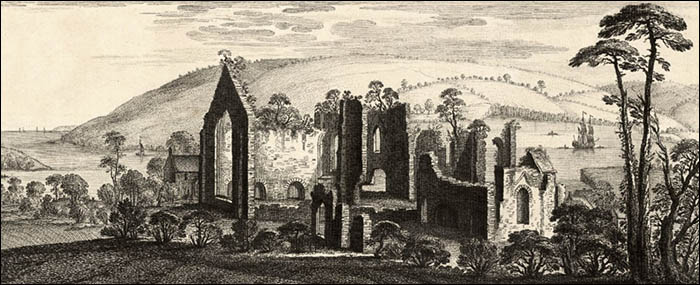Remains of St Dogmaels Abbey
Near the Coach House Visitor Centre stand the surviving parts of a medieval abbey. The site’s history of Christian worship goes back even further. You can see local Christian carvings from about the 4th century onwards inside the coach house.
The old church here was given c.1115 by Robert FitzMartin, Lord of Cemais, to the newly founded Tiron Abbey, near Chartres, France. Members of the Tiron order established a priory at St Dogmaels. The priory was soon enlarged and reclassified as the order’s only abbey in Wales.
 Gerald of Wales and the Archbishop of Canterbury spent a night at the abbey during their tour of Wales in 1188 to recruit for the third crusade. Gerald’s journal records that the accommodation was comfortable. It also tells how God had punished unjust men in the cantref (district) of Cemais. One was killed by a mass invasion of venomous toads. Another dreamed of finding gold if he reached into a stream by a certain rock, but when he went there and put in his hand he was bitten by a snake and died.
Gerald of Wales and the Archbishop of Canterbury spent a night at the abbey during their tour of Wales in 1188 to recruit for the third crusade. Gerald’s journal records that the accommodation was comfortable. It also tells how God had punished unjust men in the cantref (district) of Cemais. One was killed by a mass invasion of venomous toads. Another dreamed of finding gold if he reached into a stream by a certain rock, but when he went there and put in his hand he was bitten by a snake and died.
King Henry III gave money for the abbey’s upkeep in 1246. A century later, the Black Death reduced the number of monks there. In 1402 the Bishop of St Davids was so concerned at the monks’ lifestyles that he ordered them to stay within the abbey grounds, unless they had special permission to leave!
One of the abbot’s duties was to stand on a large stone by the river at Netpool to bless the fishing at the start of the season in February.
The abbey closed in 1537, under King Henry VIII’s dissolution of monasteries. It’s thought that part of the abbey church was used as a parish church in the 17th and 18th centuries.
The drawing of the abbey ruins in 1740 is shown here courtesy of the National Library of Wales.
The current church, north of the abbey ruins, was built in the old abbey grounds in the mid-19th century and contains a stone inscribed with Latin and Ogham. Part of the earlier church on the same site is visible in the 1740 drawing (left of the tall ruined gable wall).
The Victorian coach house, built with stone from the abbey, provided stables and vehicle storage for the new vicarage nearby. It now houses an arts and heritage centre, art gallery and café, and is used for community events.
Postcode: SA43 3DX View Location Map
Website of Coach House Visitor Centre – detailed history, opening times and more

